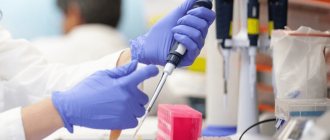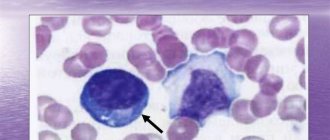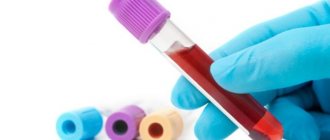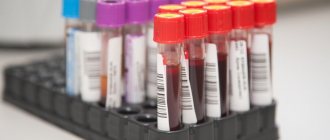Testing for syphilis has long been included in routine medical observation. Pregnant women are prescribed this test without fail before going to the hospital. The results of the study may be required during medical examination, as well as in some organizations when applying for a job. Laboratory diagnosis of syphilis is currently at a good level of development, but despite this, new cases of the disease appear every year.
Interpretation of the result
How to interpret the results of analysis on RW?
- "-" negative reaction.
- “+”, “++” weakly positive reaction.
- “+++” positive reaction.
- “++++” is a strongly positive reaction.
If the Wasserman reaction is positive, a person should immediately consult a venereologist to prescribe further research, and if the disease is confirmed, prescribe adequate treatment and observation.
Referral form for blood test Wasserman reaction
After all, with timely treatment, there is a greater chance of complete relief from the disease and prevents its transition to a chronic form. Moreover, a disease such as syphilis does not go away without a trace, it can cause serious consequences and threaten a person’s life.
RW positive
What tests are prescribed after RW + (positive)? If the result of a blood test for syphilis is positive, do not get upset ahead of time, as this does not always accurately indicate the presence of the disease. In order to confirm or refute the presence of a terrible diagnosis, it is necessary to undergo a number of additional studies.
We know that RW is a nonspecific test, that is, when it is carried out, it does not determine the presence of the bacterium itself, but only signs of its vital activity are visible, and this gives rise to the possibility of errors during diagnosis.
The final diagnosis of syphilis can only be made after three different tests: one nonspecific and two specific (treponemal) tests, which determine the presence of the pathogen.
Nowadays, blood can be tested for syphilis in almost any clinic or medical center. Due to the fact that the incidence of syphilis in the country ranks first among STDs, great assistance is provided in the diagnosis and prevention of this disease.
Preventive measures
But, despite all the measures taken by our medicine, this does not stop the spread of the disease completely, so every reasonable person must take care of his own health.
- avoid casual sex;
- eliminate the use of alcohol and drugs;
- using a condom;
- in case of unexpected contact, within two hours it is necessary to use an antiseptic, for example miramistin or cidipol. If more than 6 hours have passed, all measures will be in vain.
To prevent infection, you must adhere to several of the above rules. “Many diseases are much easier to prevent than to treat.” This statement, like nothing else, fits the disease - syphilis.
Course of syphilis
Syphilis occurs in three phases:
- formation of syphilitic chancre and inflammation of the lymph nodes;
- the appearance of rashes on the skin with a high level of risk of infection for healthy people;
- absence of obvious symptoms with a critical degree of infectiousness.
A pregnant woman infected with syphilis poses a high threat to her embryo, which may be born sick.
30% of people seeking advice for the first time are diagnosed with stage 3 syphilis. In such situations, irreversible destructive processes are observed in the bones, meninges and internal organs. For diagnosis, a blood test is taken for syphilis.
Top article: What is syphilis - symptoms and signs of the disease
What it is
A blood test for RW stands for Wasserman reaction. This analysis is over a hundred years old. The test received this name in honor of an immunologist who lived in Germany. He proposed a special study, thanks to which one can easily determine the presence of syphilis infection and other sexually transmitted diseases in the body.
The disease practically does not manifest itself in any way for a long time, the patient lives, communicates with people and does not even suspect such an infection, and at the same time infects others.
In the 20th century, such a blood test for RW was officially accepted in Russia. Today, the Wasserman reaction is mandatory for absolutely all people. A blood test for RW must be taken when planning conception, during pregnancy
A German immunologist, while studying the composition of the blood of a sick person, discovered paired chains capable of attracting the causative agent of syphilis; such a reaction can prevent the destruction of red blood cells in the blood. In the body of a healthy person, such processes are absent.
Decoding
In the primary stage of the disease, blood is taken for bacterioscopic examination, where the pathogen is visible under a microscope. Today, serological testing is gaining popularity, making it possible to isolate microbial antigens and antibodies produced by the body in tissues and organs.
In principle, doctors do not trust the results of a general blood test, since the pathogen may not be active in artificial materials.
Top article: What tests for STIs exist - description and preparation
Categories of people to be examined
There is a need to examine individuals for HIV infection, HBsAg, HCV who have had contact with infected people; such a study will limit the development and transmission of the disease. There are also special groups of professions that have contact with infected people.
The RW test is carried out for the purpose of prevention:
- Persons working in food enterprises.
- Medical staff.
- Persons with drug addiction.
- Donors.
- Persons in contact with infected people.
- Persons who initially applied to a medical institution.
- Patients admitted for inpatient treatment or surgery.
- Patients who have had a high temperature for a long time without visible symptoms.
In addition to the above groups of people, the following are also subject to mandatory examination:
- Pregnant women.
- Patients having bone pain.
- People who have casual sex.
- Patients with rashes on the body, copious discharge from the genitals.
The need for tests
Routes of infection:
This disease can only be contracted from a carrier, for example during sexual intercourse. If you suspect contact with such a person, you should immediately contact a medical facility for testing.- Not so long ago, congenital cases of the disease were observed when bacteria were transmitted from a sick mother to the child in the womb.
- It is also possible to transmit the disease during the transfusion of contaminated blood to a healthy person, but now such cases are detected by a medical examination before conceiving a child or directly during pregnancy; in the first 4 months it is possible to cure the mother through complex therapy, preventing infection of the fetus.
When receiving blood at transfusion points, all tests to detect diseases are carried out, thus, most cases of syphilis infection in the past are prevented in the present.
About false positives
But, despite the high sensitivity and specificity of this test, false positive values are also possible when performing RPGA for syphilis. They occur infrequently, in no more than 2.6% of cases, and appear when antibodies circulate in the patient’s blood that are very similar to syphilitic ones, but are not them. These may be autoantibodies, and most often such “surprises” are thrown up by systemic lupus erythematosus.
Also, those diseases that are caused by other representatives of treponemes, or spirochetes, can lead to false-positive values, for example, Lyme disease, which is caused by Borrelia burgdorferi, a “close relative” of syphilis. You can read about the diagnosis of Lyme disease, or tick-borne borreliosis, here. In some cases, such distortions are caused by oncological pathology, pregnancy, and even sluggish acute myocardial infarction. In the latter case, particles of necrotic cardiac muscle enter the blood, which are similar in structure to cardiolipin antigen; it is used to stage the Wassermann reaction, and is extracted from the heart of cattle.
Also, the cause of false positive results may be cases of intravenous drug addiction, HIV infection and viral hepatitis B and C, leptospirosis and relapsing fever, as well as diseases that occur in hot countries and are caused by treponemes - pinta, yaws, bejel. In rare cases, in patients with low immunity, treponemes, which are saprophytes and live in the oral cavity, may be activated. Also, tuberculosis and infectious mononucleosis can cause such reactions, as in the case of extensive polytrauma and numerous fractures.
Such false-positive reactions must be rechecked after some time; they usually disappear within six months, for example, after resolution of pregnancy or for a longer time.
Diagnosis of false-positive syphilis
The doctor's task is to distinguish a syphilitic infection from a false positive reaction.
To do this you need:
- assess for symptoms;
- confirm the presence of the pallidum spirochete using direct detection methods (if possible);
- do other serological tests.
Initially, the diagnosis of syphilitic infection is not made if there is only one positive test.
A minimum of two laboratory tests are required.
If both are positive, the diagnosis is confirmed.
If the tests are conflicting, additional examination is required.
Ideally, it is advisable to identify the causative agent of syphilis using one of the following methods:
- dark field microscopy;
- PCR confirms the presence of pale spirochete DNA.
To do this, it is necessary to take biomaterial from the place where the bacterium is supposed to be localized.
In the primary period of the disease, this is primary syphiloma or lymph node puncture.
In the secondary – elements of a rash.
In the tertiary period, it is rarely possible to identify the pathogen directly.
It is found in gummas and tubercles in minimal concentration.
In the absence of symptoms, only indirect methods can be used for diagnosis.
In this case, additional serological tests are performed.
Arguments that speak in favor of the presence of a syphilitic infection:
- high antibody titers;
- an increase in their titer over time;
- retention of positive tests after 6 months of observation;
- the appearance of symptoms of syphilis;
- medical history (contact with a source of infection);
- exclusion of diseases that may cause false-positive reactions.
False results are indicated by:
- low titers;
- presence of concomitant pathology;
- decrease in antibody titer over time;
- their disappearance several months later;
- no symptoms of syphilis;
- conflicting results of the same study if the reaction is performed with different sets of antigens.
RPGA as a reconfirmation method
Therefore, if the patient’s Wasserman reaction is positive, then to confirm or refute the RW results, it is necessary to perform a passive hemagglutination reaction. The specificity of RPHA ranges from 96 to 100%. Even with latent syphilis without any manifestations, she can also make a diagnosis with almost 100% probability.
Since the rules for diagnosing syphilis necessarily require reconfirmation of the primary diagnosis by another method, then if the primary diagnostic method is the RPGA itself, then it also needs to be reconfirmed, despite its high sensitivity, but only using another method. And then the treponemal test is also used, but only a different one, for example, you need to decipher new values using the enzyme-linked immunosorbent assay (ELISA).
Indications for diagnosis
There are several indications for which it is imperative to undergo appropriate research. This is especially true for a pregnant woman, who must take a detailed test for the presence of the causative agent of a sexually transmitted disease three times: the first is taken when she is registered, the second - at 31 weeks, the third - before giving birth. If a pregnant woman receives a positive test for syphilis, then the baby is also prescribed examinations after birth. Other indications:
- The patient suspects that he has syphilis. Many patients are afraid of rashes on the genitals.
- There was an intimate relationship with a person with syphilis.
- The patient is in prison.
- A person wants to become a donor and needs to donate sperm and blood.
- The need to pass a medical examination to be hired. This applies to all those who get a job in a school or kindergarten, hospital, cafe, sanatorium, grocery store, etc.
- If the patient has enlarged lymph nodes (lymphadenitis), or has been diagnosed with an unspecified fever.
- A person takes drugs.
Types of tests for syphilis
Today, serological tests of human blood for syphilis are mainly carried out. These analyzes are based on the mechanism of formation of antibodies in the human body and their reaction with a specific antigen. Serological blood tests are used for the purpose of primary diagnosis and monitoring of the therapy process.
The Wasserman reaction (RW) is a rapid diagnosis of syphilis. The material for the study is the patient's blood from the ulnar vein. During the test, a person's blood sample is injected with the cardiolipin antigen and the reaction is observed. At 6–8 weeks of the course of the disease, 90% of studies show a positive result for primary syphilis, and 98–100% for secondary syphilis.
In some cases, a positive RW result is also possible in healthy people (for example, with blood diseases, tuberculosis, systemic lupus erythematosus, leprosy, malaria). In addition, a positive response can occur during pregnancy, menstruation, after anesthesia, childbirth, drinking alcohol or medications, or vaccination. In these cases, in order to clarify the diagnosis, other methods of testing for syphilis are used.
Passive hemagglutination reaction (RPHA). This method consists of determining specific antibodies to the pathogen in human blood serum. If a pathogen is present in the blood, agglutination (sticking and sedimentation) of red blood cells occurs. The result of the reaction can then be assessed by coloration. As a rule, a positive result of RPGA remains even after treatment of the disease, with the exception of situations where it was carried out at the very beginning of the disease.
Microprecipitation reaction with cardiolipin antigen (RPR). The action of this method is based on the determination of IgM and IgG antibodies. A positive test for syphilis in the primary form of the disease is 78% of cases, and in the secondary form - 97%. A false-positive reaction can occur in diseases such as scleroderma, systemic lupus erythematosus, and some viral and bacterial infections.
Enzyme-linked immunosorbent assay (ELISA). This method is one of the most promising today. Its principle of action is based on the detection of a specific antigen-antibody complex. ELISA is effective in detecting syphilis after 21 days from the moment of infection. Even after therapy, a positive test for syphilis may occur using this method.
Immunofluorescence reaction (RIF). During this study, the intensity of the glow of Treponema pallidum (the causative agent of syphilis) in a special preparation is determined. This reaction is carried out with serum of different concentrations. RIF is used for early diagnosis of the disease. It is extremely rare that false-negative and false-positive results may be observed when performing an immunofluorescence reaction.
Treponema pallidum immobilization reaction (TPIRT). This method is considered the most specific test for syphilis. RIBT is based on the ability of the serum of a patient infected with syphilis to immobilize the pathogen. In turn, the serum of healthy people does not have this ability. This test is used to detect latent forms of syphilis. In addition, it is often used to establish whether a person has been cured of an illness.
It is important to note that false positive results are very rare with this method.
There are many tests to determine syphilis. What specific method a person needs, and where to get tested for syphilis, can be recommended by the attending physician.
What tests are taken for syphilis and where does the biomaterial come from?
To identify the disease, a general blood test is required for syphilis, which is why blood can be taken.
From it, specialists isolate antibodies to the treponema bacterium and pathogen DNA. Or treponema can be detected by scraping from a rash or ulcer that appears with syphilis.
There are other alternatives to detect Treponema DNA. You can donate urine, cerebrospinal fluid, and scrape the mucous membrane.
There are many options for biomaterials to explore. In particular, these are biomaterials from organs that have suffered from syphilis.
Schematic explanation
In approximately 90% of all recorded cases, primary syphilis is successfully diagnosed using the standard Wasserman reaction. But only if it is carried out at least from the sixth week after the alleged unprotected sexual contact.
The average statistical reaction involves the absence of pronounced indicators in the first 15-17 days. But already in the fifth week, about a quarter of the subjects can get a reliable result. However, experts insist that for final personal peace of mind, you need to wait until the end of the eighth week, and only then go to take the RW.
When it comes to the secondary phase, everything happens here regardless of time intervals. The procedure will identify pathogens without significant obstacles, if they are still present in the body.
But here the doctor rarely gets by with just one RW. It is usually necessary to include several more serological reactions for completeness, which will allow us to more accurately determine the approximate time of infection.
Particular attention should be paid to syphilitic infection in the fourth week of the disease, when primary syphiloma appears. At this moment, the Wasserman reaction passes from negative to positive, consolidating for the rest of the time, while the stage of secondary fresh and secondary recurrent course passes
Best materials of the month
- Why you can't go on a diet on your own
- How to keep vegetables and fruits fresh: simple tricks
- How to curb your sweet cravings: 7 unexpected products
- Scientists say youth can be extended
When it comes to the secondary period without treatment, RW is sometimes still able to return to a negative indicator. But as soon as a clinical relapse of syphilis occurs, the situation returns to a more familiar one.
Against this background, experts never tire of repeating that the latent period of the disease is extremely insidious. Wasserman’s negative reaction does not indicate anything, including final cure. The only positive aspect, provided that the treatment was previously prescribed and properly carried out, is a favorable prognosis for further rehabilitation.
As for the active lesion at the tertiary stage, a clear result can be seen in most of the analyzes performed among patients. But after the extinction of active manifestations at the tertiary stage, the reaction becomes negative.
Such fluctuations sometimes baffle even experienced specialists, so trying to decipher a document from a laboratory on your own is a difficult task. It is better to place such burdensome responsibilities on the shoulders of the attending doctor.
It is especially important to trust your doctor if you have a seroresistant form. It indicates that vigorous antisyphilitic therapy has not borne fruit.
Cyclically checking the dynamics in such a situation is pointless.
After completing the blood sampling procedure, experts advise maintaining a balanced diet throughout the day and drinking more fluids. Alcohol should also be excluded. Additionally, you will have to give up physical activity, pampering yourself with a piece of chocolate and warm tea instead.
More fresh and relevant information about health on our Telegram channel. Subscribe: https://t.me/foodandhealthru
Author of the article:
Izvozchikova Nina Vladislavovna
Specialty: infectious disease specialist, gastroenterologist, pulmonologist.
Total experience: 35 years.
Education: 1975-1982, 1st MMI, San-Gig, highest qualification, infectious disease doctor.
Scientific degree: doctor of the highest category, candidate of medical sciences.
Training:
- Infectious diseases.
- Parasitic diseases.
- Emergency conditions.
- HIV.
Other articles by the author
Preparation for the procedure
It is quite difficult to detect treponema pallidum even with a blood test, so in order to obtain the most reliable results, you should follow some rules:
- Blood sampling is performed strictly on an empty stomach;
- One hour before the test, you should stop using tobacco products;
- Do not drink alcohol for several days before blood sampling;
- no fatty foods two days before the test;
- Two days before the collection, you should not expose your body to heavy physical activity.
If you are taking any medications, you must inform your doctor about this. You also need to convey to him information about pregnancy and recent vaccinations. These circumstances can distort the test result, making it a false positive or false negative.
There are a number of diseases that often lead to distortion of indicators. These include:
- diabetes;
- vasculitis;
- lupus erythematosus.
In addition, any viral infection developing in the body can give a false result. Therefore, one of the additional, but not mandatory conditions for testing for syphilis is an examination of the general condition of the body.
Syphilis is a very dangerous sexually transmitted disease. This is fraught with numerous consequences from different systems and organs. You can find out exactly what consequences appear with this disease.
Some patients are concerned about how long the blood test takes. In fact, the entire procedure can take just one day. But some clinics are somewhat delaying this process. The reason is not the complexity of the technology itself, but the workload of the laboratory - if its specialists examine samples from a large number of patients at once, then they will need more time. In addition, the clinic’s equipment plays a certain role in the speed of obtaining results. If it is old and was created back in the Soviet era, then the research period can take up to three days even with zero workload in the laboratory.
Failure to comply with the conditions for preparing for the analysis will not affect the patient’s health in any way. However, data distortion in such conditions is almost guaranteed. This leads to a false diagnosis and loss of time needed for treatment.
Advantages and disadvantages
ELISA is very often prescribed for suspected syphilis or other infectious diseases. This is due to the fact that the analysis allows us to identify the exact type and stage of the disease, and its reliability remains at a high level - the probability of error based on the results of multiple studies is only 1%, the primary ELISA has an accuracy of about 90%.
The use of high-quality reagents and modern equipment allows us to maximize the accuracy of indicators.
In general, the advantages of the method are:
- High accuracy of results. The likelihood of receiving false data is very low.
- Minimizing the human factor of influence. Modern equipment for conducting ELISA eliminates human influence on the results of the study due to automation of the process.
- Identification of specific antibodies. It is impossible to confuse antigens of one type with others, so the analysis shows the exact result for a specific diagnosis.
- Recording the slightest deviations from the norm. Even the smallest concentration of pathological agents will not go unnoticed.
We should not forget about the weaknesses of this method. ELISA has the following disadvantages:
- High price. The high cost is due to many factors, in particular, the need for good equipment, high-quality reagents and specialists with a sufficient level of training.
- The need for a preliminary diagnosis. You need to know which antigens to look for, since without additional data it will be impossible to make an accurate diagnosis.
- Probability of a false positive result. Certain body conditions and other factors may distort the final data.
False positive test
The question often arises: can the results be erroneous? Yes, especially when using non-treponemal tests. The causes of acute false-positive samples when using RMP are:
- injuries, poisoning;
- stroke;
- pneumonia;
- myocardial infarction;
- acute infectious diseases.
If controversial results appear, specialists resort to treponemal serological tests to clarify the diagnosis. It should be borne in mind that chronic false-positive tests often occur when:
- tuberculosis;
- leptospirosis;
- brucellosis;
- malignant tumors;
- liver cirrhosis;
- diabetes mellitus;
- sarcoidosis;
- rheumatic diseases;
- infectious mononucleosis, etc.
Blood test
Depending on the specific stage of development the pathology is at, subsequent therapy will differ. But to establish the stage, it is impossible to do without an appropriate clinical trial.
The name of each phase will indicate the severity of the disease. Thus, primary syphilis indicates the formation of a specific ulcer. In professional terminology, it is called chancroid. At the same time, the victim’s lymph nodes become inflamed.
If you donate blood from a vein at the initial stage of the lesion, you will be able to achieve the highest productivity of the subsequent therapy program. But if you ignore the primary alarming symptoms, you can only reach secondary syphilis.
It is characterized by the appearance of a special skin rash. The victim also becomes extremely contagious, posing a significant threat to others. Since the internal reserve of strength goes to fight the infection, the immune system gradually weakens. This suggests that catching hepatitis or any other disease of this kind is becoming much easier.
The latent course, when there are no typical signs of damage, is considered separately. Only a specific laboratory test can detect them. But being asymptomatic does not mean that the victim has ceased to be infectious. Particularly dangerous is the possibility of transmitting the infection from mother to fetus.
The final stage, called tertiary, includes severe skin lesions, destruction of the brain, bones and internal organs. This happens to approximately a third of all those infected, most of whom simply waited until the last minute or were not treated properly.
The basis for modern tactics of examining a prospective patient is not only a survey and examination, as it was a hundred years ago. Now the main tool in establishing an accurate diagnosis is a specific test, which requires the victim’s blood.
We are talking about testing for antibodies of the IgG and IgM classes. The first option indicates possible identified antibodies to the pathogen. It is not for nothing that among doctors it is briefly called simply the “treponemal test.”
The second version involves studying nonspecific antibodies. Here the basis is based on the detection of components that are released from cells destroyed by the causative agent of the disease.
This approach has several names, but they all retain the same general principle:
- nonspecific antiphospholipid test;
- nontreponemal anticardiolipin test;
- reagin test.
All of the above is based on the foundation laid in the RW algorithm, which means the Wasserman reaction.
Both clinical solutions are used not only for diagnosing pathology. They are used during potent therapy to assess the ongoing dynamics of recovery, and after treatment.
The only difference between the two procedures is the results of the examination of a person who has already successfully overcome the disease. Thus, non-treponemal results at the end of a successfully completed drug course will show the absence of a reaction. A negative response is explained by the absence of biological processes associated with the destructive effects of the pathogen on healthy cells of the body.
But the treponemal analogue, even after the period of successful treatment has ended long ago, will forever be positive. It follows that a positive response does not always guarantee relapse.
In addition to the two most popular diagnostics, there are several more that are used a little less frequently for various reasons, but they are still practiced in laboratories.
This is about:
- RPGA;
- RIBT;
- immunoblotting.
If a serological approach is relevant, the strategy can be expanded even further. It usually covers ELISA. But you should learn about the features of bladder cancer and MCI from your attending physician individually.
Decoding the results
In a comprehensive diagnosis of syphilis, it is important to carry out several tests that complement each other. The table below presents the interpretation of the examination results depending on the indicators of non-treponemal and treponemal tests.
| Non-treponemal | Treponemal | Possible results |
| — | — | The man is healthy and has not had syphilis. |
| Primary syphilis at an early stage of development (1 week after infection). | ||
| Successfully cured primary syphilis 7-14 months after therapy. | ||
| Sometimes: HIV-infected patients with active syphilis. | ||
| +- | — | False positive result. |
| — | + | Initial forms of infection some time after successful treatment. |
| Primary form of syphilis. | ||
| Secondary form of infection. | ||
| Late (characterized by the formation of gumma) syphilis in the absence of adequate therapy. | ||
| Patients with syphilis with autoimmune pathologies, neoplasms, and concomitant infectious processes. | ||
| + | + | Untreated patients with syphilis at any stage. |
Syphilis is a disease that can cause serious complications for the life and health of the patient. But it develops very slowly, over several years, and this means that a person has enough time to undergo examination and promptly defeat the infection in his body.
False results
Regardless of how much testing is done and what particular format of laboratory diagnostics was chosen, there is always a risk of error. In medical practice, it accounts for about 5% of the total number of diagnosed cases.
Usually, victims with an incorrect verdict receive a false positive result. Various diffuse connective tissue diseases can affect poor performance. Even classic rheumatoid arthritis can affect the reliability of your own information. The same applies to systemic lupus erythematosus.
But most often, a more trivial reason such as diabetes or the patient’s recent vaccination becomes an obstacle. An identical picture can be seen if the patient has a number of severe infectious diseases such as mononucleosis or tuberculosis. Viral hepatitis or heart muscle diseases can also reduce the quality of the information provided. This is especially true for endocarditis.
People who suffer from alcoholism in the most advanced stages, or who take drugs, regardless of their specific type, are also at risk of getting an unreal result.
Situations where false negative values appear are much less common. The reason for such confusion will be only one aspect - too early diagnosis. Occasionally, the same clinical picture can be seen in those who are in the late stages of syphilis. This affects the infection at a phase when antibody production has almost completely stalled.
Reactions after suffering from syphilis
Only those reactions that are registered in humans are considered false positive:
- not suffering from syphilis;
- have never been infected with this disease in the past.
If a person has ever had syphilis, he may have a positive test result even after he has completed a course of therapy and got rid of this disease.
But such reactions are no longer considered false positives.
This phenomenon is called seroresistance.
It is stated if:
- reactions remain positive for 1 year or more after the end of the therapeutic course;
- During this time, there was no tendency for the level of reagin antibodies to decrease.
Most often, this problem occurs in those patients in whom syphilis was detected and treated at a late stage.
The question of whether they need to be treated again has not yet been finally resolved.
Causes of residual positive serological reactions:
- late diagnosed and treated disease;
- concomitant somatic pathology;
- preservation of foci of syphilitic infection in the body in an inactive form, in areas difficult to reach with antibacterial drugs;
- transition of pale spirochetes into L-forms or cysts.
Some researchers believe that seroresistance is not associated with remnants of pale spirochetes in the body.
It is caused by allergization of the body and autoimmune reactions.
In any case, seroresistance is an indication for re-treatment.
It is carried out once.
If the reactions to syphilis continue to be positive, but there are no other signs of this infection, then the patient is only monitored.
Repeated therapy is not prescribed.
The person is observed for a total of 3 years after completion of treatment.
The essence of the study
Enzyme immunoassay is one of the most common methods for diagnosing infectious diseases. It belongs to the category of treponemal tests, that is, it can be used to determine the presence of the causative agent of syphilis - treponema pallidum - in the patient's body.
ELISA diagnostics helps determine the presence of Treponema pallidum in the human body.
Using the ELISA method, syphilis is detected by detecting antibodies to treponema. They are contained in the patient’s blood, and their type and quantity depend on the stage and form of the disease, which allows one to obtain important information about the current state of human health.
This method is also used to diagnose other sexually transmitted and infectious diseases, in particular autoimmune, parasitic, systemic, etc.
Symptoms of syphilis
Symptoms of syphilis depend on the stage of the disease. In general, there are two of them: the primary stage and the secondary.
In the primary stage, an ulcer appears with a very hard base, but no pain occurs.
After just a couple of weeks, the lymph nodes that are located closer to the ulcer become enlarged. And within six weeks the ulcer heals on its own.
Important! Do not forget that with any rash on the skin, and even more so if it is on the genitals, you must consult a dermatologist and get tested for syphilis rpr.
Secondary syphilis manifests itself ten weeks after the ulcer appears. At this stage, an unpleasant rash may appear randomly throughout the body, even on the soles and palms.
In addition, severe headaches and high fever may occur. The condition is the same as with a common cold and there is an increase in lymph nodes. The secondary stage can last for several years.
Therefore, urgent treatment is necessary so that the disease does not worsen and the infection cannot affect all organs and tissues of the human body. After which a number of diseases may develop, including hepatitis.
People who are HIV positive should be especially careful, given that a syphilitic ulcer can cause HIV transmission.
Interesting fact
In ancient times, the expression “star fever” was not at all connected with the dizzying success of an individual. This is what people called syphilis because the ulcers, after healing, left star-shaped scars.
Positive microscopy results
Microscopic methods are widely used to identify the causative agent of this disease. These include dark-field microscopy, Romanowsky-Giemsa examination, and treponemal silver impregnation. The materials for the study are:
contents of chancre, erosions and ulcers;- punctate lymph nodes;
- smear from affected mucous membranes.
Dark-field microscopy is positive for syphilis. When light is directed onto a slide with a patient’s specimen, pale treponemas begin to glow against a completely dark background. They have a thin, spiral shape and are capable of various types of movements (translational, rotational, flexion). Treponemas have several whorls.
For syphilitic infection, analysis using the Romanovsky-Giemsa method is very informative. The preparation is stained with special substances, dried and examined under a microscope. An oil medium is used for this. The analysis is positive if microbial cells are visually detected. The pink color allows you to distinguish pale treponema from other spirochetes. Less commonly used in the diagnosis of syphilis is the silver impregnation method, in which the pathogen turns dark brown or black.
Ways of infection with syphilis
There are several opportunities for a man to become a carrier of treponema and hear the extremely unpleasant diagnosis of syphilis.
Sexual transmission
Any sexual contact with a carrier of the bacteria that is not protected by a barrier method leads to a 100% chance of infection. The fact is that the causative agent of syphilis exists in all body fluids of the carrier: saliva, vaginal lubrication, blood. Even a one-time touch to an infected liquid gives a fairly high chance of transmitting the pathogen, and these chances do not depend on the stage of treatment or on the stage of development of the disease itself - syphilis will be dangerous for a man, even if it is in a latent form.
It is worth dispelling the myth that oral sex is a guarantee of safety: this is not true, and syphilis is transmitted through any form of contact. Anal sex will not be an exception: the risks of micro-tears in the intestine are much higher than in vaginal tissue, and a condom is rarely used during anal sex.
Domestic infection
It is more difficult to become infected through saliva, cigarettes, cups and other household items, but this is also quite possible.
Syphilis obtained in this way is called domestic syphilis.
To avoid infection, it will be enough to follow the rules of banal hygiene.
Infection through blood
If a person is transfused with the blood of a person with syphilis, infection occurs. Despite mandatory screening of blood donors, the risks are quite high. Often the bacterium is transmitted through a shared syringe - which is why people who take drugs are at risk.
Occupational hazards
Often, medical personnel become victims of both accidents and their own negligence: having been dealing with potentially infectious secretions of patients for years, doctors consider themselves a special “caste” that will never get sick, which is why they neglect protective equipment.
There are known cases of infection when a surgeon’s hand is wounded with a scalpel, patients’ secretions come into contact with the mucous membranes and skin, micro-traumas during autopsies, dental procedures, and childbirth.
Infection through the placenta
Congenital syphilis is transmitted to the fetus from a sick mother and, unfortunately, often the child does not even survive to birth. The pale spirochete can enter the child’s body through breastfeeding.
To reduce risks, doctors avoid artificial birth and immediately switch the baby to formula feeding.
What to do if syphilis is confirmed?
There is no need to worry if you receive an initial screening with positive results. False syphilis is easily determined by repeated testing. If the diagnosis has been confirmed, you need to take measures:
- examination of the sexual partner by a dermatovenerologist;
- examination of close relatives;
- performing preventive treatment to prevent infection in loved ones;
- registration of sick leave for the period of treatment - the sick leave does not contain information about the diagnosis, guaranteeing confidentiality;
- At the end of the course of treatment, a special certificate is issued - you need to have it with you in order to avoid questions about false positive results in the next few months.
A positive result for syphilis is not always reliable. Therefore, there is no need to worry and it is recommended to wait for additional research. Proper treatment, which was started on time, guarantees a quick recovery with a minimum of residual effects.
Causes of false positive results
A false positive result is considered to be a positive test result in the absence of disease.
Important! A false-positive test must be distinguished from seropositivity and seroresistance after therapeutic therapy. Carrying out non-treponemal tests gives an error in the results of up to 20%, while carrying out treponemal tests is practically not accompanied by errors, the number of cases does not exceed 2%.
The reasons for a false-positive test for syphilis may occur if:
- phospholipid syndrome;
- extrapulmonary tuberculosis;
- oncological diseases;
- enteroviral infections;
- infectious mononucleosis;
- viral hepatitis;
- Lyme disease;
- pneumonia;
- psoriasis;
- gout;
- pregnancy;
- malaria, chickenpox or measles;
- endocarditis;
- myocarditis;
- alcoholism;
- diabetes mellitus against the background of parenteral insulin compensation.
A false positive test result for syphilis during pregnancy occurs in approximately 1.5% of cases of non-treponemal tests. The reasons why false-positive results occur are not fully known, but in some pregnant women, APS is determined at the time of the analysis.
Differential diagnosis for biologically positive seroreactions in pregnant women can be carried out in the following cases:
- conflicting or weakly positive results;
- controversial results (one test is positive and the second is negative);
- in the absence of history and signs of syphilis in the pregnant woman and partner.
There are cases in which it is not possible to absolutely confirm the fact of a false positive reaction. Then specific therapy is allowed, since the risk of consequences from congenital syphilis is higher than the harm from antibacterial therapy.
What to do in case of a false positive result?
No one is immune from errors, even diagnostic tests that detect syphilis. If you receive a positive result, you should not panic ahead of time - if you are confident in yourself and your partner, most likely the result is false, and the test needs to be redone.
To do this, you need to contact a dermatovenerologist. At the appointment, the doctor will take a medical history and examination, and prescribe repeated tests. For more accurate results, it is not recommended to carry out the test using the method that produced an erroneous result.
It happens that even a second test shows a positive result, in which case a more thorough examination is recommended using two types of tests - treponemal and non-treponemal. With this combination, the possibility of an error occurring is less than 1%.
From the photos and videos in this article, we learned that the likelihood of getting false positive results for syphilis is quite high, especially during pregnancy, and we also learned about pathologies that can also affect the reliability of the results.
The doctor should answer any questions you have about the disease











